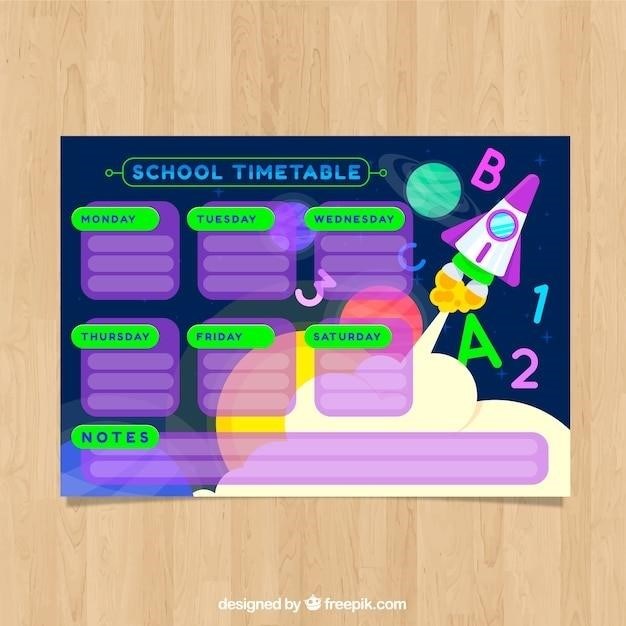Test Preparation Strategies for Elementary Students
Effective test preparation for elementary students involves a multifaceted approach. This includes establishing consistent study routines, reviewing material effectively using various techniques, and practicing different question types. Early introduction of these strategies builds confidence and reduces test anxiety.
Pre-Test Preparation⁚ Establishing a Routine
Creating a consistent study routine is crucial for elementary students preparing for tests. This routine should be established well in advance of the test date, not just the night before. A sample schedule might involve a dedicated study time each day, perhaps after school or before dinner. This consistent time helps create a habit and reinforces the importance of preparation. The routine should include breaks to prevent burnout and maintain focus. Short, frequent study sessions are often more effective than one long, intense session. Incorporating active recall techniques, like flashcards or practice questions, is highly beneficial. The routine should also include sufficient sleep and a healthy diet to optimize cognitive function. Regular physical activity can also improve concentration and reduce stress levels, making the study process more manageable and efficient. Parents and teachers can play an active role in supporting the student by helping them create and maintain this routine, providing encouragement, and ensuring a conducive study environment.
Pre-Test Preparation⁚ Reviewing Material Effectively
Effective review strategies are key to successful test preparation for elementary students. Avoid cramming; instead, spread review sessions over several days. Begin by reviewing the main concepts and key terms covered in class. Use a variety of techniques to engage different learning styles; Flashcards are excellent for memorizing vocabulary and facts. Summarizing key points in one’s own words helps solidify understanding. Practice tests, either from the textbook or created by the teacher, allow students to identify areas needing further attention. Working with a study buddy can facilitate active recall and collaborative learning. Make use of visual aids like diagrams or mind maps to organize information and make connections. For subjects like math, working through practice problems is essential. Encourage students to explain their reasoning aloud, which helps solidify their understanding. Remember that effective review is not just about rereading notes; it’s about actively engaging with the material and testing one’s understanding.

During the Test⁚ Time Management Techniques
Effective time management is crucial for success on elementary-level tests. Before starting, quickly scan the test to gauge its length and difficulty. Prioritize easier questions to build confidence and momentum; tackle challenging ones later. Allocate a specific time limit for each section or question type, based on point values or difficulty. Use a watch or timer to stay on track. If stuck on a question, don’t spend excessive time on it; move on and return later if time permits. Avoid rushing through questions; take a deep breath and approach each one systematically. Keep an eye on the clock throughout the test, adjusting pacing as needed. If time is running out, focus on answering as many questions as possible, even if it means guessing on some. Remember, completing the test is more important than perfection. After finishing, review your answers if time allows, looking for careless errors or missed opportunities. Practice these techniques beforehand using sample tests to build proficiency and reduce test-day anxiety.
During the Test⁚ Approaching Different Question Types
Elementary tests often include various question types, each requiring a unique approach. For multiple-choice questions, carefully read each option before selecting an answer. Eliminate obviously incorrect choices to increase the odds of selecting the correct one. If unsure, make an educated guess rather than leaving it blank. For true/false questions, look for keywords that indicate truth or falsehood. Pay close attention to qualifiers like “always,” “never,” “all,” and “none,” as they often signal incorrect statements. For fill-in-the-blank questions, consider what kind of answer is expected (e.g., a number, a word, a phrase). Use context clues within the sentence to guide your response. For short-answer or essay questions, plan your response before writing. Organize your thoughts logically and use complete sentences. For math problems, show your work clearly to potentially earn partial credit even if the final answer is incorrect. Remember to reread and proofread your answers before moving on to the next question, checking for any careless errors or omissions.
During the Test⁚ Strategies for Multiple-Choice Questions
Multiple-choice questions are a common feature of elementary school tests. To tackle them effectively, begin by carefully reading the question stem, understanding precisely what’s being asked. Then, analyze each answer choice individually, eliminating any obviously incorrect options. Look for keywords or phrases that align with your knowledge of the subject matter. If you’re unsure of the answer, try to eliminate as many incorrect choices as possible before making an educated guess. Avoid changing your answer unless you’re absolutely certain you made a mistake. Sometimes, your initial instinct is correct. If you’re running short on time, focus on answering the questions you know well first, then return to the more challenging ones if time permits. Remember, even if you’re not entirely sure, making an informed guess is better than leaving the question unanswered. Consider the context of the question and the overall test material; sometimes, the answer can be inferred from related questions or passages. Don’t rush; take your time to thoughtfully consider each choice before selecting your final answer.

Post-Test Reflection and Improvement
Post-test reflection is crucial for growth. Analyze your performance, identifying both strengths and weaknesses. This self-assessment informs the development of a personalized test-taking plan for future success, incorporating memory aids and effective study strategies.
Post-Test Reflection⁚ Analyzing Performance
After completing a test, encourage students to take time for thoughtful reflection rather than immediately focusing on the grade. This reflective period is vital for learning and improvement. Begin by reviewing the test as a whole. Did the student finish within the allotted time? Were there sections where they felt rushed or unsure? Identifying these patterns can pinpoint areas needing attention in future test preparation and time management. A thorough examination of individual questions is next. For each question, students should analyze their response. Was their answer correct? If so, how confident were they in their choice? If incorrect, what led to the mistake? Was it a misunderstanding of the question, an oversight of key details, or a lack of knowledge on the topic? This detailed analysis provides valuable insights into the student’s understanding and helps to highlight areas requiring further study. Encourage students to note recurring patterns of error – do they consistently struggle with a certain type of question, or do they make similar mistakes repeatedly? Understanding these recurring issues allows for targeted improvements in study methods and approach. Finally, emphasize the importance of learning from mistakes, rather than feeling discouraged by them. The ultimate goal of this post-test reflection is not just to understand performance, but to use the experience to improve future results. By pinpointing specific areas of weakness, students can create a personalized learning plan focused on addressing those challenges.
Post-Test Reflection⁚ Identifying Strengths and Weaknesses
Following a test, a critical step in improving future performance is to identify both strengths and weaknesses. Begin by reviewing the test and highlighting questions answered correctly. This process reinforces successful strategies and builds confidence. Analyze the types of questions answered correctly. Were these questions based on concepts the student found easy to grasp? Did they utilize specific study methods that proved successful? Identifying these patterns helps reinforce effective learning techniques. Next, focus on incorrectly answered questions. For each incorrect answer, determine the reason for the mistake. Was it due to a lack of understanding of the core concept, a careless error, misinterpreting the question, insufficient time to fully consider the answer, or perhaps an ineffective test-taking strategy? Understanding the root cause of each error is crucial for developing targeted improvement plans. Categorize the errors. Are there recurring themes? Do errors consistently occur in specific subject areas or question formats? This analysis helps identify specific areas requiring more focused study and practice. Document these strengths and weaknesses. Create a list outlining areas where the student excels and areas needing improvement. This list serves as a valuable tool when designing a personalized study plan. Remember, this reflection process aims to foster growth and improvement, not to dwell on mistakes. By acknowledging both successes and areas for growth, students can build self-awareness, identify targeted areas for improvement, and develop strategies to excel in future assessments.
Developing a Personalized Test-Taking Plan
Creating a personalized test-taking plan empowers elementary students to approach assessments with confidence and strategy. This plan should be tailored to the individual student’s learning style, strengths, and weaknesses, identified through post-test reflection. Begin by scheduling dedicated study time. Consistent, shorter study sessions are generally more effective than cramming. Break down larger study tasks into smaller, manageable chunks. This prevents overwhelm and improves focus. Incorporate a variety of study techniques. Experiment with different methods such as flashcards, practice quizzes, summarizing notes, and teaching the material to someone else. Identify preferred learning styles. Does the student learn best through visual aids, hands-on activities, or auditory learning? Tailor study methods to match these preferences. Develop a time management strategy. Practice pacing oneself during practice tests. Learn to allocate sufficient time for each section or question type. Prioritize difficult concepts. Dedicate extra time and effort to areas where the student struggles. Incorporate relaxation techniques. Test anxiety can significantly impact performance. Teach students relaxation exercises like deep breathing or visualization to manage stress before and during the test. Review and refine the plan regularly. The personalized plan isn’t static. Adjust it based on performance on practice tests and assessments; Regularly evaluate and adapt the plan for optimal effectiveness. This individualized approach fosters a proactive and positive attitude towards assessments, turning test preparation into a personalized learning journey.
Utilizing Memory Aids and Techniques
Effective memory aids significantly boost recall during tests. For elementary students, incorporating diverse techniques caters to various learning styles and enhances retention. Visual aids, like mind maps or diagrams, transform abstract concepts into easily digestible visual representations. These aids are especially beneficial for visual learners. Acronyms and mnemonics are powerful tools for memorizing lists or sequences. Creating memorable phrases or sentences using the first letters of items to be remembered strengthens recall. For instance, ROY G. BIV helps remember the colors of the rainbow. Chunking information breaks down large amounts of data into smaller, manageable pieces. This prevents cognitive overload and improves comprehension. Repetition and spaced repetition are crucial for long-term retention. Regularly reviewing material at increasing intervals strengthens memory pathways. Flashcards are an excellent tool for implementing spaced repetition. Active recall techniques encourage students to retrieve information from memory without looking at notes. This process strengthens memory consolidation. Practice testing simulates the actual test environment, improving recall under pressure. Regular practice tests familiarize students with the format and question types. Storytelling transforms information into engaging narratives. Weaving facts into relatable stories boosts memory and comprehension. The use of rhymes and songs can aid memorization of facts and vocabulary. Pairing information with songs or rhymes makes learning more engaging and memorable. Combining these memory aids creates a robust toolkit for students, enhancing their ability to access and utilize learned information during tests.